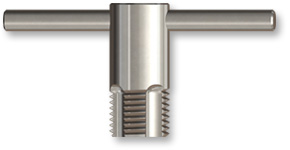
Overview
D/F Machine Specialties provides protective sheaths to help prevent damage and extend the life of the casing/conduit, water in hose, Water Out & Power Cable, and gas hose on all torches. It is also a means of providing a tight, clean harness of all the utilities from the torch to the wire feeder, Utility Station, etc. Depending on the model purchased, the sheaths will come in various materials: Stitched Black, Velcro Black, or Stitched Blue. See below to determine which replacement sheath is needed for your specific torch.
Ordering Information
| REF. | CODE NO. | DESCRIPTION | USED WITH NOZZLE ASSEMBLY |
USED FOR GAS NOZZLE |
|---|---|---|---|---|
| 1 | 14610 | Nozzle Thread Chaser Tap for Standard A/C & W/C Nozzle Assembly Front |
13197 16184 11117, 45101 11118, 45102 11119, 45103 45114 45107 NCC-N/HTC-N NCC-LRN, HTC-LRN |
10340 10359 10362 10374 |
| 2 | 14611 | Nozzle Thread Chaser Tap for BIG MIG & BIG TIG Nozzle Assembly Front |
11123 | 10382 10387 10389 10390 10392 15907 |
| 3 | 14614 | Nozzle Thread Chaser Tap for Series A High Capacity Nozzle Assembly Front |
11142, 45120 11138, 45121 45127 11132, 45129 45125 |
16748 16749 16750 16751 18030 18031 18032 |
| 4 | 14615 | Nozzle Thread Chaser Tap for Nozzle Body Assembly Front |
13198 | 10379 |
| 5 | 14617 | Nozzle Thread Chaser Tap for Tandem Nozzle Assembly Front |
41641 | 41667 41668 |
Proper Use of a D/F Nozzle Thread Chaser Tap
CAUTION: Incorrect use of a Nozzle Thread Chaser Tap can cause severe damage to a Nozzle. Do not cross-thread the Nozzle. Also, do not tap past the last threads in the Nozzle. Always make sure the threads are clean.
All D/F Nozzles are hand checked for fit before & after plating, and checked again before shipping. If a nozzle has been installed on a new complete torch, they have also been hand checked while being assembled.
The only reason to ever take a gas cup out a nozzle is to clean it. The nozzle and the gas cup must be blown out, and all of the threads have to be wire brushed and blown out again before hand-tightening the gas cup back in the nozzle. If you can’t thread it in by hand, something is wrong. Never force a gas cup into a nozzle.
- Make sure that the nozzle is properly supported when tapping so that it does not twist in the front of the torch body and cause damage.
- Improper support can cause the spigots to twist off the top of the rear nozzle collar, or damage the torch internal body parts.
- Note where the water ports go down the sides of the water-cooled nozzle (following down in line with the spigots). Too much direct pressure on these water ports could cause them to cave in and block of the flow of water.
- Best practice is to hold the water-cooled nozzle in a vice with soft jaws, perpendicular to the spigots.
- Over-tightening of the vice can cause damage in general.
- Remove the tip from the front of the torch before tapping.
- Lightly lubricate the nozzle and nozzle thread chaser tap before tapping.
- Be sure to start the tap very carefully. Do not cross thread the nozzle.
- Be very careful to start threads correctly. Only tap 1/2 turn at a time, always backing up and removing chips 1/2 cycle at a time before moving forward. Do not try to tap further into the water-cooled nozzle than needed or past the factory thread depth.
- Blow out the nozzle after tapping.
- Wire brush and blow off the gas cup before threading it back into the nozzle.
- If nozzle is badly deformed or damaged please return to the factory for a repair estimate before disposing of product (damaged parts can often be repaired).

